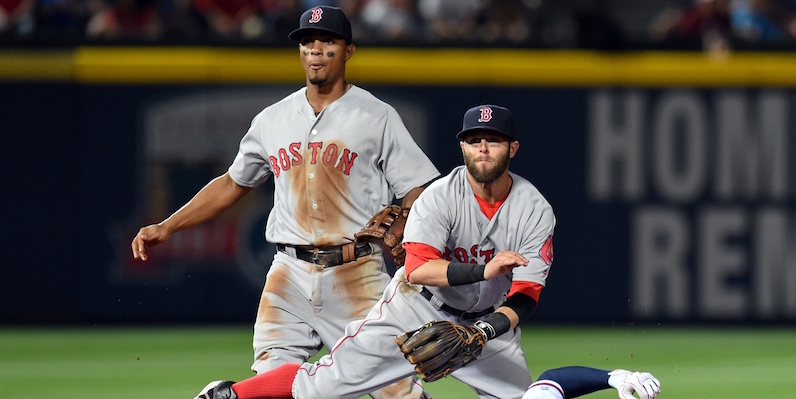There are no shortage of good stories for the Red Sox heading into the final month. Jackie Bradley’s ascension, #FeatsofMookie, and David Ortiz’s MVP-level final season all spring easily to mind. Also Sandy Leon! Probably even more than that. All of those stories are getting covered, many here! All deserve the coverage they’re getting. But the attention paid to them has allowed Dustin Pedroia to put up a vintage season without much fanfare. This might actually be the best news the Red Sox could receive this season from a long-term standpoint.
To start with what Pedroia has done this season we need to go back a bit. In 2010, Pedroia hit .278/.337/.376. Nothing wrong with that. It’s perfectly fine from a good-fielding second baseman, and indeed he was worth 3.6 WARP that season, primarily on the strength of his fielding. Offensively, he had fallen way back from his prime years of 2008 through 2010. Those seasons he hit .307/.372/.475, made the All Star team each season and won the MVP award (2008). But by 2010 Pedroia had fallen from an MVP candidate to a decent second baseman. That’s a hefty fall, like coming off a fire escape and there’s only a small bag of garbage to break your fall.
Jump ahead to mid-2013. Then GM Ben Cherington signed Pedroia to a seven year, $100 million contract that wouldn’t begin until 2015. The Red Sox were taking a chance on a franchise player, but one whose slugging percentage had gone from .493 in 2010 to .474, .449, and finished the season at .415. The following season it dropped again to the previously mentioned .376. That’s all before the extension kicked in. Suddenly the Red Sox were looking at paying $100 million to peak Omar Infante.
Last season was a step back in the right direction for Pedroia’s slash stats, but at age-31 he only lasted for 93 games. This represented the other problem with giving that contract to Pedroia, namely that second baseman don’t typically last a long time in the big leagues. Maybe it’s the physical nature of the position or the kind of player who generally lands there, but second baseman don’t tend to have long careers. Pedroia looked like he might not escape that generalization.
This season has been the first positive indicator since the Red Sox gave Pedroia his extension.
He still might not escape it, but this season has been the first positive indicator since the Red Sox gave Pedroia his extension. Look simply at his home runs. He’s at 12 now, his most since 2012 and with three more (hardly difficult to imagine over the next 40 games) he’ll surpass that season’s 15. He could still, with a power surge, make a run at his career high of 21 from 2011.
Of course there’s more to Pedroia than home runs. His batting average is back over .300 and his on-base percentage is up over .370. The biggest indicator of Pedroia’s return to offensive prominence is his ability to drive the up-and-in pitch for power. Swinging at pitches at his eyes must have been a jarring thing for manager Terry Francona to see when Pedroia first came up. How does a 5’7 guy hit a neck-level pitch let alone drive one? But Pedroia could always do it. And then, over the last two seasons, he couldn’t. This season he’s not only hitting the pitches up and in the strike zone but he’s clubbing the pitches up and in that are so far up and in they’re not even strikes. That’s more like vintage Pedroia.
The one reason to be a bit concerned is Pedroia’s defense. If you look at his defensive numbers here at BP, we have him rated as a negative fielder (-2.3 FRAA). That’s part of the reason he’s only been a two WARP player so far this season despite the offensive resurgence. The good news is that, if you look a bit further afield, FRAA is the only advanced defensive stat that doesn’t like Pedroia defensively this season. That’s why he rates so much better overall by both FanGraphs’ and Baseball Reference’s version of WAR. By their judgement he’s almost a four win player and a positive defensive player.
I haven’t watched every second baseman play defense this season but I have watched an awful lot of Dustin Pedroia so I’m prepared to say it looks to me like maybe he has lost a half step. It’s not coming in range or straightaway speed, but it seems like Pedroia has mishandled more balls than I remember him doing in the past. Pedroia’s always been sure-handed so I wouldn’t expect that to change much overall. A few more bobbles or errors aren’t any real indicator of decline, at least not like a lack of range or arm strength would be and Pedroia isn’t lacking in either of those categories yet.
Just as Dustin Pedroia took a chance on the Red Sox when he signed his first extension with the team, the Red Sox took a chance on Pedroia by giving him the second extension. There are real concerns about signing an aging player already showing signs of decline to such a long term deal. Those concerns aren’t gone, but at least for now, this season, Pedroia has put some of them to rest. He’s stayed healthy, his power has returned, and his defense has mostly stayed in tact.
Pedroia isn’t the star of the team now, but he’s one the guys who keeps the middle of the roster strong. More than that, he’s one of two guys whose faces you think about immediately when someone brings up the Red Sox. Next season he’s going to be the face of the franchise and the team’s longest serving member. It’s a good sign that while serving in that capacity, he’s shown a renewed ability to contribute at the plate and in the field.
Photo by Dale Zanine/USA Today Sports Images
